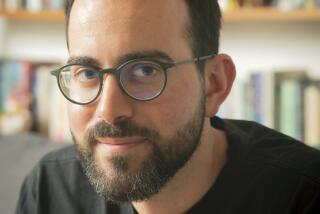The man who invented ‘Big Science,’ Ernest Lawrence
- Share via
In early 1946, half a year after atomic bombs devastated Hiroshima and Nagasaki, the U.S. government awarded Ernest Lawrence the Medal for Merit. Presiding over the ceremony was Gen. Leslie Groves, military commander of the Manhattan Project, for which Lawrence provided most of the weapons-grade uranium.
“We bet $100 million on him and won,” Groves proclaimed, revealing a gamble unprecedented in the history of science. Lawrence graciously accepted the medal — and used it to request more funding.
Lawrence was one of the foremost physicists of the 20th century, a Nobel laureate in the same league as Ernest Rutherford and Marie Curie. Yet what set him apart from his forebears — and became his most far-reaching legacy — was his scientific method. “He was a scientific impresario of a type that had seldom been seen in the staid world of academic research,” writes Michael Hiltzik, a Los Angeles Times columnist as well as author. “Far from solitary, he presided over a team of energetic young scientists and graduate students — physicists, chemists, medical doctors, and engineers, all toiling and cogitating in interdisciplinary harmony — and managed millions of dollars with the assurance of a corporate executive.”
MORE: 27 nonfiction books you’ll want to read -- and share -- this summer
In other words, as Hiltzik persuasively shows in this absorbing and expansive biography, Ernest Lawrence invented Big Science. Almost singlehandedly he created the context for enormous (and enormously expensive) collaborative efforts such as the $10-billion Large Hadron Collider.
Experimental physics was a small-scale pursuit when Lawrence began his career at UC Berkeley in 1928. Less than a decade earlier, Rutherford reported the first splitting of the atom, which he achieved with a handmade apparatus that fit neatly in his lap. Rutherford’s technique was fiendishly clever; his atom-splitting bullets were naturally generated by radioactive decay. Yet as Hiltzik notes, Rutherford’s simple experiment produced more questions than answers, questions that could be addressed only by splitting larger atoms by hitting them harder with higher-energy mortar.
Lawrence figured out a way just one year after his arrival in Berkeley, while reading about a device that accelerated charged particles with small nudges of electricity. He recognized that the particles could be fired at atoms, breaking them apart, but to achieve enough acceleration would require a machine several yards long, inconceivably big by the standards of the time. Lawrence’s breakthrough insight was that he could nudge particles to great speeds by sending them in a spiral and that particles would naturally follow a spiral path if they were propelled in a vacuum chamber enveloped by an electromagnetic field. He dubbed his invention the cyclotron and — like a latter-day Archimedes — went running across campus proclaiming that he was going to be famous.
MORE: Get ready to be obsessed by these 29 page-turners
Lawrence’s plan was feasible given the technology then available but not easy given his scant resources. The initial prototypes, jerry-rigged by a graduate student, resembled “whisky flasks run over by a truck,” writes Hiltzik. A second grad student proved handier, establishing proof of concept with a palm-size brass device, on the strength of which Lawrence started fundraising to buy a bigger electromagnet.
As Hiltzik documents, the rest of Lawrence’s brief life was spent in pursuit of ever-larger machines. (Lawrence died in 1958 at age 57.) Bigger cyclotrons could probe the internal structure of the atom in greater detail. It turned out they could also produce artificial isotopes for nuclear medicine and (with modification) could electromagnetically isolate weapons-grade uranium. Filling whole buildings, they were phenomenally effective research tools with multiple practical applications that Lawrence could evoke in pursuit of more cash from philanthropic organizations and military brass alike.
However “the drive toward bigger and better created its own logic,” Hiltzik observes. “Every discovery made with a cyclotron opened new vistas for physicists to explore; solving every new riddle demanded machines of even greater power.” This cycle of ambition, argues Hiltzik, has outlived Lawrence, becoming both the main engine of Big Science and the major threat to its future.
By some measures, Big Science is thriving. The UC Berkeley lab Lawrence founded — now known as Lawrence Berkeley National Laboratory — continues to produce Nobel Prize-winning research, and the Large Hadron Collider follows Lawrence’s plan to build ever-more-powerful accelerators. Other indicators, such as congressional stinginess toward high-energy physics and space exploration, suggest that the internal logic of Big Science cannot withstand outside economic factors. Each discovery is more expensive and often more abstruse. The very premise of Big Science may not be sustainable nor supportable, regardless of scientific merit.
Beyond the sheer thrill of the story, Hiltzik’s delightful book is invaluable as a basis for reckoning how Big Science can persevere and evolve. Lawrence’s persona “gave Big Science its lasting character,” Hiltzik astutely notes. Big Science preserves some of Lawrence’s best ideas (such as interdisciplinary teamwork), some of his personal foibles (such as an instrumentalist mania for machinery) and even some of his character flaws (such as a willingness to do almost anything for money).
Seeing where Big Science came from, we can be more critically attuned to outmoded assumptions. Equally important, we can be more attentive to new methodologies as revolutionary as Lawrence’s.
::
Big Science
Ernest Lawrence and the Invention that Launched the Military-Industrial Complex
Michael Hiltzik
Simon & Schuster: 528 pp., $30
Keats is the author of “Virtual Words: Language on the Edge of Science and Technology.” His new book on the legacy of Buckminster Fuller will be published in 2016.
More to Read
Sign up for our Book Club newsletter
Get the latest news, events and more from the Los Angeles Times Book Club, and help us get L.A. reading and talking.
You may occasionally receive promotional content from the Los Angeles Times.







